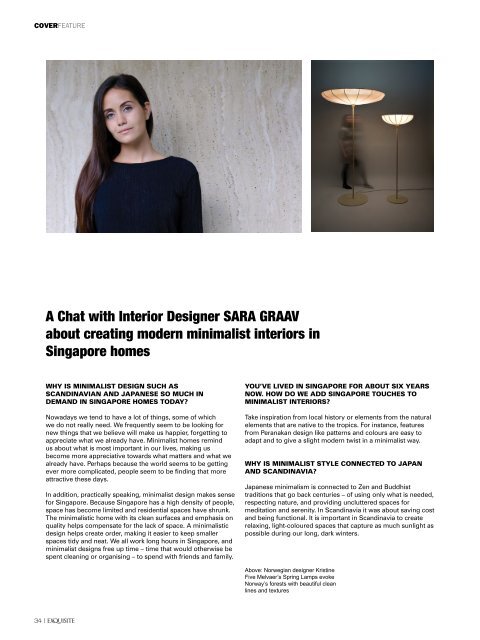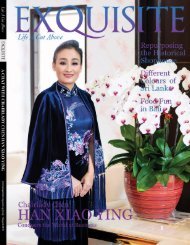Exquisite May 2018
Create successful ePaper yourself
Turn your PDF publications into a flip-book with our unique Google optimized e-Paper software.
COVERFEATURE<br />
“Modern minimalism<br />
continues to evolve,<br />
and has become very<br />
open to different<br />
usage of materials<br />
with a wider range of<br />
colours and texture.”<br />
A Chat with Interior Designer SARA GRAAV<br />
about creating modern minimalist interiors in<br />
Singapore homes<br />
Why is minimalist design such as<br />
Scandinavian and Japanese so much in<br />
demand in Singapore homes today?<br />
Nowadays we tend to have a lot of things, some of which<br />
we do not really need. We frequently seem to be looking for<br />
new things that we believe will make us happier, forgetting to<br />
appreciate what we already have. Minimalist homes remind<br />
us about what is most important in our lives, making us<br />
become more appreciative towards what matters and what we<br />
already have. Perhaps because the world seems to be getting<br />
ever more complicated, people seem to be finding that more<br />
attractive these days.<br />
In addition, practically speaking, minimalist design makes sense<br />
for Singapore. Because Singapore has a high density of people,<br />
space has become limited and residential spaces have shrunk.<br />
The minimalistic home with its clean surfaces and emphasis on<br />
quality helps compensate for the lack of space. A minimalistic<br />
design helps create order, making it easier to keep smaller<br />
spaces tidy and neat. We all work long hours in Singapore, and<br />
minimalist designs free up time – time that would otherwise be<br />
spent cleaning or organising – to spend with friends and family.<br />
You’ve lived in Singapore for about six years<br />
now. How do we add Singapore touches to<br />
minimalist interiors?<br />
Take inspiration from local history or elements from the natural<br />
elements that are native to the tropics. For instance, features<br />
from Peranakan design like patterns and colours are easy to<br />
adapt and to give a slight modern twist in a minimalist way.<br />
Why is minimalist style connected to Japan<br />
and Scandinavia?<br />
Japanese minimalism is connected to Zen and Buddhist<br />
traditions that go back centuries – of using only what is needed,<br />
respecting nature, and providing uncluttered spaces for<br />
meditation and serenity. In Scandinavia it was about saving cost<br />
and being functional. It is important in Scandinavia to create<br />
relaxing, light-coloured spaces that capture as much sunlight as<br />
possible during our long, dark winters.<br />
Above: Norwegian designer Kristine<br />
Five Melvaer’s Spring Lamps evoke<br />
Norway’s forests with beautiful clean<br />
lines and textures<br />
What materials, furnishings, colours and<br />
lighting work best for minimalist interiors?<br />
Wood, stone, concrete, metal and glass. Natural materials<br />
such as wood and stone give a sense of purity while adding a<br />
sense of depth. They create a connection between the natural<br />
environment, the site and the occupants. Concrete, metal and<br />
glass, in contrast, help create more simplicity and openness.<br />
They are easy to take care of and to maintain.<br />
Modern minimalism continues to evolve, and has become<br />
very open to different usage of materials with a wider range of<br />
colours and texture, while neutral colours such as white, light<br />
grey and beige are still commonly used. These colours are<br />
simple and create a nice contrast to materials like wood, stone<br />
and concrete. For example, white ceilings and walls allow a<br />
space to feel more spacious while enhancing the movement of<br />
natural light in space.<br />
Of course, natural lighting is an essential quality in minimalism.<br />
Typically, large windows are used to maximise natural light in<br />
the space and the lighter colours like white, are used to reflect<br />
the natural light. The type of furniture used is also important to<br />
how well lit a space is. For example, furniture that is elevated<br />
allows light to travel through the negative space beneath the<br />
furnishings and to better diffuse throughout the space.<br />
How do you relax after a hard day at work?<br />
Put on my comfy clothes, cook some dinner and just relax<br />
on the couch. More generally, I practise yoga to help myself<br />
disconnect and find a sense of inner peace.<br />
If a young girl tells you she wants to be an<br />
interior designer like you what advice would<br />
you give her?<br />
Find a good school with teachers that are professionals in the<br />
field. When it gets tough and you face difficulties do not search<br />
for an easy way out by cutting corners. Work hard and believe<br />
in yourself.<br />
tinyurl.com/sarakogr<br />
34 | EXQUISITE<br />
EXQUISITE | 35
















